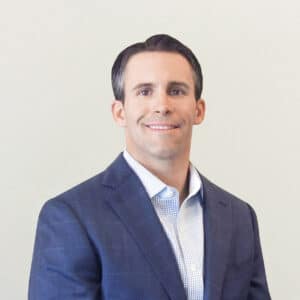Michael Weber
Principal, Gaston Electrical
Age: 39
Industry experience: 18 years
Before global corporations like Amazon, Wayfair, and Boeing can occupy new buildings in Boston & Cambridge, developers rely on Gaston Electrical to provide reliable connections to the grid. With over $100 million in 2018 revenues, the Norwood-based contractor has ramped up its business from tenant fit-outs to core-and-shell construction for projects including UMass-Boston dorms, the Boston Celtics’ new training facility in Brighton and Amazon’s future office tower in the Seaport. Michael Weber and his brother William split the leadership duties for the company, which has 275 employees.
Q: How do you and your brother divide the leadership roles at Gaston Electrical?
A: We’re a third-generation family-owned company in our 85th year. We started in 1934 and as far as my own involvement, my brother and I are partners. He started in 2001 after business school and I started in 2002 after Boston College.
The company itself has changed dramatically over the years. Personally, I started out in high school driving a truck and have worn a thousand hats since then. After I graduated from college, I worked in the field for three years, transitioned to the office, and learned how to estimate and work as a chief project manager and then as head of field operations as we’ve grown. There’s still a lot of overlap, candidly. We talk every few hours or every day about something, but the operations and marketing fall under me, and human resources and accounting and estimating fall under him.
Q: How are the company’s business lines evolving?
A: Within the past couple of years we’ve added more services than just construction. We have a service department where we have 12 or so trucks with electricians in the field. We’ve got 40 tel-data technicians in the field and that’s taken off quite successfully. As far as vertical markets, we used to do tenant improvements and now we’re doing core–and–shell in life science projects, hospitals and more.
We’re doing the core-and-shell for the J-K parcel at Cambridge Crossing, which is wrapping up this week, and the tenant interior fitout for Philips North America at Cambridge Crossing which will be done by year end. We’re also doing a core-and-shell in Cambridge for MITIMCo and Turner Construction in Kendall Square, and the L4 [Amazon] parcel in the Seaport is just kicking off. There’s a lot going on.
Q: How much more labor-intensive are lab projects?
A: From an electrical standpoint, it’s much heavier. We have redundancies with generators and power and they’re much more HVAC–heavy, which requires more power as well. It really starts with the coordination upfront. The ceilings in these lab buildings are packed with all sorts of piping. It’s really power-heavy. These types of projects have much more labor than a typical office fitout. The schedules are typically longer due to the complexity of the fitouts as well. It’s been an area of success we focused on in the early 2000s, trying to get away from being just a TI contractor, and it’s been great for us.
Q: How is the “smart building” movement affecting the type of electrical equipment being installed in office and multifamily buildings?
A: When I hear “smart buildings,” I tend to immediately think of IoT and everything being connected within a building, tracked and optimized, controlling all systems with a single laptop: HVAC, fire alarm, security and energy efficiency. The industry is not really there yet.
These days we have integrated control systems, LED lighting. Everything is very efficient. The lights dim when the sun comes in. Office lights turn off when vacancy sensors tell them. These things are code now. They’re not just nice things to have.
Those things require much more technological knowhow, and you need to understand how to pieces interact. There are many more parts and pieces on an install, more sensors and relays that 20 years ago did not exist. Every six months the codes change, and it’s important to understand these so our estimators can price them right and the installers can install them right.
Q: What’s the latest frontier in resiliency planning?
A: With Boston and fear of rising seas, we’ve looked at lots of existing buildings in the Financial District to move whole electrical rooms and the basement [equipment] to first and second floors. Historically, we haven’t seen it prior, but it’s a real thing. Along the same lines, we’re seeing large neighborhoods like Cambridge Crossing and the Seaport installing infrastructure with redundant network systems as well.
Q: How tight is the labor market for electricians, given the level of building activity in Greater Boston?
A: It’s been mostly full employment in the last five years in the Boston market. For Gaston specifically, although labor has been tight, we’ve been successful in only chasing the work we can do with the staff we have: 275 electricians and staff. We bet on ourselves and made a strategic decision to only chase the jobs we can handle. Our reputation is based on our ability to take on a successful project.
Q: What’s the best way to diversify your business to insulate from the next downturn?
A: If I had a crystal ball, I’d love to know the answer. In our experience in Boston, medical and educational historically have been busy when the rest of the economy is not. I’d also anticipate our service group would become busier, and that’s been a focus for us so when the big core-and-shell high rises aren’t happening, we’ll have a backlog in the service work. But I don’t see it in the next 12 months, and probably not even in 24.
Weber’s Five Favorite Golf Courses:
- Pine Valley Golf Club
- Merion Golf Club (East)
- The Kittansett Club
- The Ocean Course
- Oakmont Country Club




 |
| 

